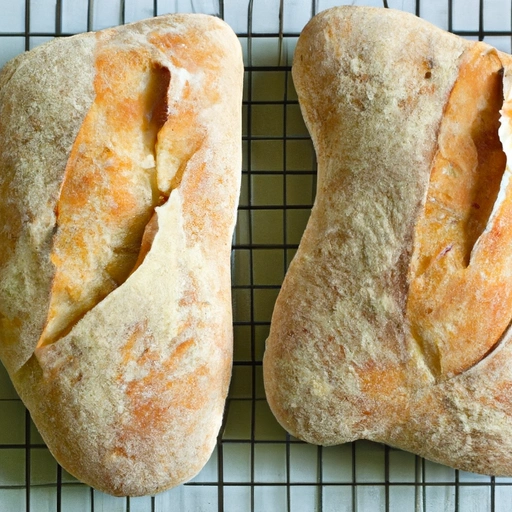Ciabatta
Description

Ciabatta is an Italian white bread made from wheat flour, water, salt, yeast, and olive oil. Known for its chewy texture and porous crumb, ciabatta has become a popular ingredient in various culinary traditions. It is characterized by its broad, flat shape and rustic appearance, with a crisp crust and soft, airy interior. This bread is not just a staple in Italian cuisine; it has found its way into sandwiches and bread baskets around the globe, making it a beloved choice for chefs and food enthusiasts alike.
Common uses
Ciabatta is commonly used as the bread of choice for panini, a type of grilled sandwich. It also serves as an excellent base for bruschetta, works beautifully in bread salads like panzanella, and can be used for dipping in olive oil or hearty stews. The bread's open crumb structure and sturdy crust make it ideal for absorbing flavors while maintaining its integrity, which is why it is frequently featured in both casual and high-end culinary settings.
Nutritional value
Calories
Typically, a 57g (2 oz or approximately 1/6 of a loaf) serving of ciabatta contains about 130-150 calories.
Protein
Each serving may contain around 4-5 grams of protein, depending on the specific recipe used.
Fat
Ciabatta generally has a low-fat content, with around 1-2 grams per serving.
Carbohydrates
The carbohydrate content in a serving of ciabatta is usually about 25-30 grams, largely from flour.
Vitamins
While not a significant source of vitamins, ciabatta may contain small amounts of B vitamins, depending on the flour used.
Minerals
It may also provide minerals like selenium, magnesium, and iron, though these are typically present in modest amounts.
Health benefits
As a source of carbohydrates, ciabatta can provide quick energy. Its protein content contributes to muscle repair and growth. Whole grain versions of ciabatta offer more fiber, aiding in digestion and promoting a feeling of fullness.
Potential risks
For individuals with gluten intolerance or celiac disease, consuming ciabatta can lead to adverse health effects. Additionally, those monitoring their carbohydrate intake, such as diabetics, should consume ciabatta in moderation due to its high carb content.
Common recipes
Ciabatta is prominently featured in recipes for sandwiches, such as the classic Italian panini, garlic bread, and various bruschettas. It also stars in bread salads and as a hearty accompaniment to soups and stews.
Cooking methods
While ciabatta is typically purchased ready-made, it can also be baked at home. The dough requires high hydration and is often baked at high temperatures to achieve its distinct texture and crust.
Pairing with other ingredients
It pairs excellently with robust flavors like garlic, tomato, basil, and balsamic vinegar, as well as with a wide range of cheeses, cured meats, and olives.
Summary
Ciabatta is an Italian bread that has been adopted by kitchens worldwide due to its versatility and delightful texture. Its ability to complement a wide range of ingredients makes it a favorite for sandwiches, soups, and salads. While offering some nutritional benefits, it should be consumed in moderation by those with certain dietary restrictions. Ciabatta's enduring popularity is a testament to its role as a cherished component in a myriad of dishes across various cuisines.